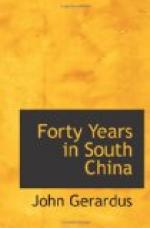“Resolved, That while the General Synod does not deem it necessary or proper to change the missionary policy defined and adopted in 1857, yet, in consideration of the peculiar circumstances of the Mission of Amoy, the brethren there are allowed to defer the formation of a Classis of Amoy until, in their judgment, such a measure is required by the wants and desires of the Churches gathered by them from among the heathen.”
At the Centenary Conference on the Protestant Missions of the World, held in Exeter Hall, London, 1888, Rev. W. J. K. Taylor, D.D., for many years a most efficient member of the Board of Foreign Missions of the Reformed Church in America, read a paper on “Union and Cooperation in Foreign Missions,” in which he said:
“Actual union has been happily maintained at Amoy, China, for more than a quarter of a century between the missionaries of the Reformed (Dutch) Church in America and those of the Presbyterian Church of England. Having labored together in the faith of the Gospel, gathering converts into the fold of Christ, and founding native churches, these brethren could not and would not spoil the unity of those infant churches by making two denominations out of one company of believers nor would they sow in that virgin soil the seeds of sectarian divisions which have long sundered the Protestant Churches in Europe and America. The result was the organization of the Tai-Hoey, or Great Council of Elders, which is neither an English Presbytery nor a Reformed Church Classis, but is like them both. It is not an appendage of either of these foreign Churches, but is a genuine independent Chinese Christian Church holding the standards and governed by the polity of the twin-sister Churches that sent them the Gospel by their own messengers. The missionaries retain their relations with their own home Churches and act under commissions of their own Church Board of Missions. They are not settled pastors, but are more like the Apostolic Evangelists of New Testament times,—preachers, teachers, founders of Churches, educators of the native ministry, and superintendents of the general work of evangelization.
“This Tai-Hoey is a child of God, which was ’born, not of blood, nor of the will of the flesh, nor of the will of man, but of God.’ It is believed to be the first ecclesiastical organization for actual union and co-operation in mission lands by the representatives of churches holding the Reformed faith and Presbyterial polity. Its history has already been long enough to give the greatest value to its experience.”
For seven years, by tongue and pen, Mr. Talmage advocated the establishment of an independent Chinese Union Church of the Presbyterian order. Even then the Reformed Church was not fully persuaded and did not give her hearty assent. The resolution of 1864 was only tentative. It was a plea for toleration. This was not strange. It was one of the earliest efforts, if not the earliest, for church union and separate autonomy on heathen soil. It was a new departure. But the battle was really won. The question was never broached again. The strongest opponents then are the warmest friends of union and autonomy now. Thirty years of happiest experience, of hearty endorsement by native pastors and foreign missionaries are sufficient testimony to the wisdom of the steps then taken.




